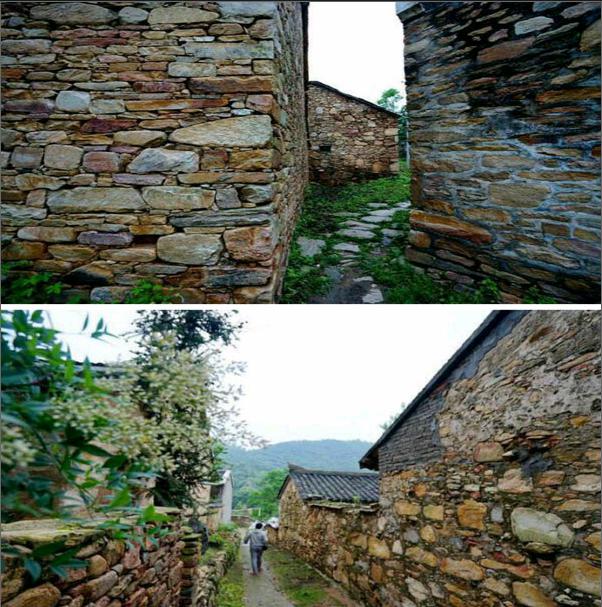百年石屋炊烟袅 万棵柿树别样红
2017-04-13

A Brief Introduction to Taoyuan Village---Century-old Stone Houses in Living Smoke, Tens of Thousands of Persimmon Trees with Special Redness.
在中国湖北省广水市,大别山与桐柏山交汇的武胜关下,有一个人与自然和谐之美的小村庄——桃源村。 桃源村源于明代嘉靖年间,丹灵毓秀,古风犹存,自然生态保护完好。明清时代的百年石屋,千亩有机茶园,万棵古柿树,曾吸引全国各地的驴友前来品茶尝柿及摄影, 被誉为“苍桑野性美”。
In Guangshui City of Hubei Province, PR China, lying below Wusheng Pass on the intersection between Dabie Mountain and Tongbai Mountain, there is a great village called Taoyuan, where man and nature are in perfect harmony. The village of Taoyuan, dating from the Jiajing years of Ming Dynasty, with the ecological system well preserved, is beautiful beyond description. Stone houses of the Ming and Qing Dynasties, and vast areas of tea farms have attracted travelers from all over the country to come to take photographs and to taste the excellence of tea here, making the village known for "the wild beauty of history".
古时的桃源曾经是广水至大悟、河南省九里关的交通要道,一脚跨两地(孝感和随州)、两县共一湾(大悟和广水)、一水分两系(长江和淮河)”是该村的一大特色。 话说桃源的百年石屋,确实有一番来历:永乐元年间,明成祖朱棣思虑迁都北京,前后从全国各地招来二十多万民工,营建都城,并开始修建他的陵寝。沈姓和江姓的两位工匠听说皇帝会在工程竣工后杀死他们,以保护布局机关的秘密,两个人寻机逃出了京城。他们一路南下,走到武胜关下的桃源村,發现山谷与世隔绝,水土肥沃,于是就地取材,开山凿石,建房定居繁衍生息,形成了后来的江家桃源和沈家桃源。先民们因地制宜,采用山石做房屋和生活器具,在村里,到处可见石碾石磨,石桌石凳,石墙石屋。特别是石头与粘土做的房屋别具特色(也有少量的土坯砖),他们采用抬梁式和穿斗式建筑构架,石头、木料、布瓦巧妙的结合,形成独特的民居模式;古柿树群落分布在桃源村山谷中,因“柿”谐音“四”,村民们为祈求自己四季平安,故有家家都有种柿子树的习惯,村里两万棵柿子树,百年以上树龄的就有600多棵。
The ancient Taoyuan Village lay on the important transportation routes from Guangshui County to Dawu County and to Jiuliguan of Henan Province. It was a unique place where, as was passed down, “one single foot of a human being could be set on two cities of Xiaogan and Suizhou”, “one village was shared by two counties of Guangshui and Dawu” and “one river flew to both the Yangtze River and Huai River”, forming a special feature. So the stone house of centuries in Taoyuan Village does have a story which goes as follows: During the Yongle Period of Ming Dynasty, the emperor planned to move the capital to Beijing, so about two hundred thousand workers from all over the country were called out for the construction of the new capital. When the emperors mausoleum began to be built, two craftsmen surnamed Shen and Jiang heard that the emperor would have them killed after the completion of the project, in order to protect the layout organs secret, so the two of them managed to catch an opportunity to escape from the building site. They fled all the way south until they came to Taoyuan Village, where they found that the village was isolated, with the land and water fertile and abundant. They started to make use of the materials they could find, building up their homes and opening up fields. As a result they settled down there and bred their later generations, subsequently forming the Taoyuan villages of Jiang family and Shen family. The ancestors of the Taoyuan Village took advantage of the materials available, using rocks to build houses and making living appliances. Stone roller mills, stone tables and stalls, stone walls and houses can be seen everywhere in the village. Houses made of stone and clay are especially distinctive (with a small amount of adobe bricks). Special and delicate architecture styles were adopted, and stone, wood, fabrics were perfectly combined to form a unique pattern of ancient dwellings. Huge numbers of persimmon trees have been grown in the valleys of the village. Because "persimmon" is homophonic to "four" in Chinese, the villagers have been growing persimmon trees to pray happiness and security for themselves, for all the FOUR seasons, and as a result every family has got the habit of planting persimmon trees. Now there are about twenty thousand persimmon trees in the village, of which more than 600 are over 100 years old.
早在春秋战国时期,鄂北豫南大部分地区都附楚、属楚,其文化、民风、民俗、民情、建筑大致相近。楚人崇尚巫术,尊从自然,信奉道教,这种思想也体现在其古民居的建筑上,人字形布瓦屋顶,承接上天恩赐的鸿福;瓦沿低垂,传递给地面的万物生灵,体现“天人合一”的思想,同时也利于排水。这些用石头泥浆堆砌成的石墙,历经几百年的风吹雨淋而不倒塌,可见我们古代桃源人民的高超的建筑技术和聪明才智。
As early as the Spring and Autumn periods, most areas in North Hubei Province and South Henan Province were attached to Chu in culture, with similar folk customs, and architecture. Chu people advocated witchcraft, respected nature and believed in Taoism, which is reflected in the ancient residential architecture. Roofs placed with clay tiles in herringbone to undertake blessings from God,tiles falling towards the ground to benefit the land creatures, not only embody the philosophy of "harmony", but also contribute to drainage. These walls made of piled stones have lasted hundreds of years of wind and rain, indicating the superb architectural technology, abilities and cleverness of the local people.
桃源村的彭二灣现居30余户人家,90多间石头布瓦民居保存最为完整,整个湾依山而建,湾中一条古老的山村街市,浑然天成、错落有致、古朴简洁,是最原始的集市遗址,这里地质结构稳定,没有地震,沉降等破坏。村中建于清朝的“七星桥”至今依然完好,正常使用。
PengErwan of Taoyuan Village has more than 30 families, with 90 stone houses best preserved. The entire residential area is built alongside the hillside, with an ancient village street running through, all the buildings well-proportioned, simple and unsophisticated, like nature itself. Here its geological structure is stable, without earthquakes or subsidence damage. The Seven-star Bridge, dating back to the Qing Dynasty is still in perfect condition and in normal use.
桃源村周边地区有众多的自然风光和人文景观,鸡公山风景区、黑龙潭风景区、全国九大名关之一的武胜关、孝子碑、将军寨、千姑寨、穆桂寨、大城寨、乐城寨等均在其5公里半径范围内,具有很高的历史价值及观赏价值 。
There are many places of natural, historical and cultural interest around the village of Taoyuan, such as the Rooster Mountain Scenic Area, the Black Dragon Pool Scenic Area, Wu Shengguan Pass, the Monument of Dutiful Son, the Village of Generals, Mogu Stronghold, Dacheng Stronghold, Lecheng Stronghold and so on, within a distance of 5 kilometers, all having great value of history and appreciation.
